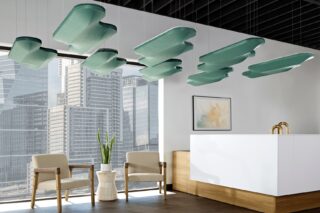In Marseille, France, the newly opened Cité Scolaire Internationale de Jacques Chirac exhibits the largest-ever application of flax-based cladding for exterior cladding.
In Marseille, France, the recently opened Cité Scolaire Internationale de Jacques Chirac is redefining sustainable architecture. This all-ages educational institution, inaugurated in September 2024, has captured international attention with its groundbreaking façade—a 5,000m² cladding system made of flax-based composites. The project represents the largest application of natural fibers in architectural history, setting a new standard for eco-friendly construction.
Crafted from ampliTex™, a flax-fiber composite developed by Swiss cleantech company Bcomp, the cladding exemplifies the potential of natural materials to replace heavier, less sustainable options like concrete.
This monumental project is a collaboration between Bcomp, French manufacturer Temca, and celebrated architects Rudy Ricciotti and Roland Carta. The building’s unique design reflects Marseille’s architectural identity, marrying form and function in a way that complements the city’s Mediterranean heritage. The school’s façade is a living example of how materials used in industries like automotive and aerospace can be adapted for large-scale public projects.
The Collaboration Behind the Innovation
Bcomp, a leader in sustainable lightweight materials, and Temca, a French manufacturing expert in composite materials have combined cutting-edge materials science with precision engineering and expert craftsmanship.
Bcomp’s ampliTex™ flax-fiber composite sits at the center of this project. It’s a natural material known for its durability, lightweight properties, and environmental benefits. Flax fibers, harvested from a plant that requires minimal water and chemicals, provide a sustainable alternative to traditional construction materials.

Temca integrated the composite by using a resin transfer molding process, a method that ensures strength while maintaining the lightweight nature of the panels. Each of the 880 openwork panels weighs between 18 and 37 kilograms, offering substantial weight savings compared to concrete. The team enhanced the panels further by adding a white gel coat designed to withstand Marseille’s intense sunlight, UV exposure, and pollution. Temca engineered the panels to optimize shading and thermal regulation, contributing to the building’s energy efficiency.
These technical advancements were achieved under the guidance of the French Scientific and Technical Centre for Building (CSTB), which provided an Experimental Technical Assessment (ATEx) to certify the material’s suitability for large-scale architectural use.
Together, Bcomp and Temca have set a new benchmark for natural-fiber composites in architecture. Their collaboration on this project demonstrates how sustainable materials can transition from niche applications to mainstream construction, paving the way for eco-friendly innovations worldwide.


Cultural and Architectural Significance
The Cité Scolaire Internationale de Jacques Chirac is more than a school; it is a cultural landmark that reflects Marseille’s rich architectural legacy while charting a sustainable path forward. Designed by Rudy Ricciotti and Roland Carta, both renowned for their work on the iconic MuCEM (Museum of European and Mediterranean Civilizations), the building’s façade draws inspiration from the region’s Mediterranean heritage and its commitment to environmental responsibility.
The trellis-like cladding serves as a visual and functional centerpiece, integrating seamlessly into Marseille’s urban landscape. From street level and classroom windows alike, the façade presents an interplay of light, shadow, and texture that evokes the natural surroundings of the Mediterranean coast. This aesthetic harmony is not merely decorative; it underscores the project’s mission to connect modern architecture with the cultural identity of its locale.
Ricciotti and Carta’s approach emphasizes the coexistence of form and function. The openwork panels not only regulate sunlight and heat but also provide a sculptural quality that enriches the city’s architectural narrative. The project highlights how innovative materials like ampliTex™ flax composites can be leveraged to create designs that are simultaneously beautiful, functional, and sustainable.
The building’s significance extends beyond its immediate community. As one of the largest applications of natural fibers in architecture, the school sets a precedent for eco-friendly construction on a global scale. It challenges traditional notions of building materials and inspires architects worldwide to rethink the role of sustainability in their designs.

In Marseille, the Cité Scolaire Internationale de Jacques Chirac stands as a symbol of progress, demonstrating how architecture can honor its cultural roots while leading the charge toward a greener, more sustainable future.
The Future of Sustainable Building Materials
The use of flax-based composites could herald a new era in sustainable building practices. Flax, the key material in Bcomp’s ampliTex™ composites, is uniquely suited for sustainable construction. As an indigenous plant requiring minimal resources, flax embodies the principles of regenerative agriculture. Its fibers provide exceptional mechanical properties, making it an ideal substitute for synthetic reinforcements. In the school’s façade, flax’s lightweight and durable nature enabled the creation of panels that reduced material consumption without compromising strength or safety.
Moreover, the collaborative approach taken by Bcomp, Temca, and their partners underscores the importance of cross-disciplinary innovation in tackling global challenges. By combining advanced materials science with thoughtful design, they have created a replicable model for sustainable construction.
The Cité Scolaire Internationale de Jacques Chirac is a blueprint for the future, demonstrating that ecological responsibility and architectural excellence can go hand in hand. It invites the global construction industry to rethink its reliance on resource-intensive materials and embrace a greener, more sustainable approach.










